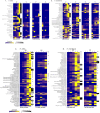Complexity of Chemical Emissions Increases Concurrently with Sexual Maturity in Heliconius Butterflies
- PMID: 38478290
- PMCID: PMC11233321
- DOI: 10.1007/s10886-024-01484-z
Complexity of Chemical Emissions Increases Concurrently with Sexual Maturity in Heliconius Butterflies
Abstract
Pheromone communication is widespread among animals. Since it is often involved in mate choice, pheromone production is often tightly controlled. Although male sex pheromones (MSPs) and anti-aphrodisiacs have been studied in some Heliconius butterfly species, little is known about the factors affecting their production and release in these long-lived butterflies. Here, we investigate the effect of post-eclosion age on chemical blends from pheromone-emitting tissues in Heliconius atthis and Heliconius charithonia, exhibiting respectively free-mating and pupal-mating strategies that are hypothesised to differently affect the timing of their pheromone emissions. We focus on two different tissues: the wing androconia, responsible for MSPs used in courtship, and the genital tip, the production site for anti-aphrodisiac pheromones that affect post-mating behaviour. Gas chromatography-mass spectrometric analysis of tissue extracts from virgin males and females of both species from day 0 to 8 post-eclosion demonstrates the following. Some ubiquitous fatty acid precursors are already detectable at day 0. The complexity of the chemical blends increases with age regardless of tissue or sex. No obvious difference in the time course of blend production was evident between the two species, but female tissues in H. charithonia were more affected by age than in H. atthis. We suggest that compounds unique to male androconia and genitals and whose amount increases with age are potential candidates for future investigation into their roles as pheromones. While this analysis revealed some of the complexity in Heliconius chemical ecology, the effects of other factors, such as the time of day, remain unknown.
Keywords: Heliconius; Aging; Androconia; Antiaphrodisiac; GC-MS; Lepidoptera; Pheromones.
© 2024. The Author(s).
Conflict of interest statement
The authors declare no competing interests.
Figures



References
-
- Agerbirk N et al (2010) Complex metabolism of aromatic glucosinolates in Pieris rapae caterpillars involving nitrile formation, hydroxylation, demethylation, sulfation, and host plant dependent carboxylic acid formation. Insect Biochemistry and Molecular Biology, vol 40. Pergamon, pp 126–137. 2 doi: 10.1016/j.ibmb.2010.01.003. - PubMed
-
- Allison JD, Carde RT. Pheromone communication in moths: evolution, Behavior, and application. Oakland: University of California Press; 2017.
-
- Andersson J, Borg-Karlson AK, Wiklund C (2000) ‘Sexual cooperation and conflict in butterflies: a male-transferred anti-aphrodisiac reduces harassment of recently mated females’, Proceedings of the Royal Society B: Biological Sciences. Royal Society, 267(1450), pp. 1271–1275. 10.1098/rspb.2000.1138 - PMC - PubMed
MeSH terms
Substances
Grants and funding
LinkOut - more resources
Full Text Sources
Miscellaneous

